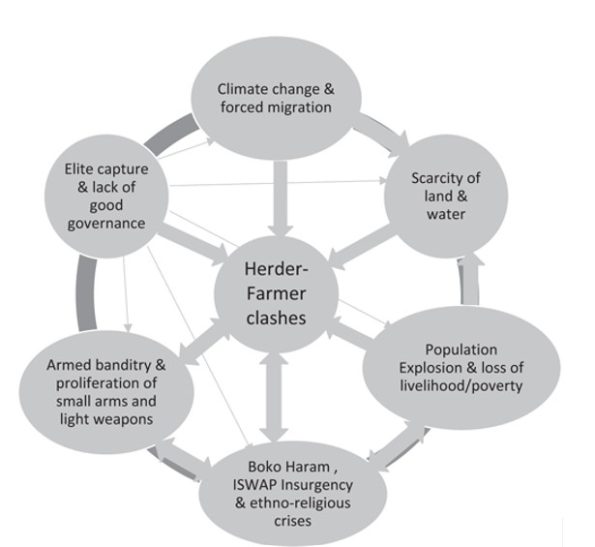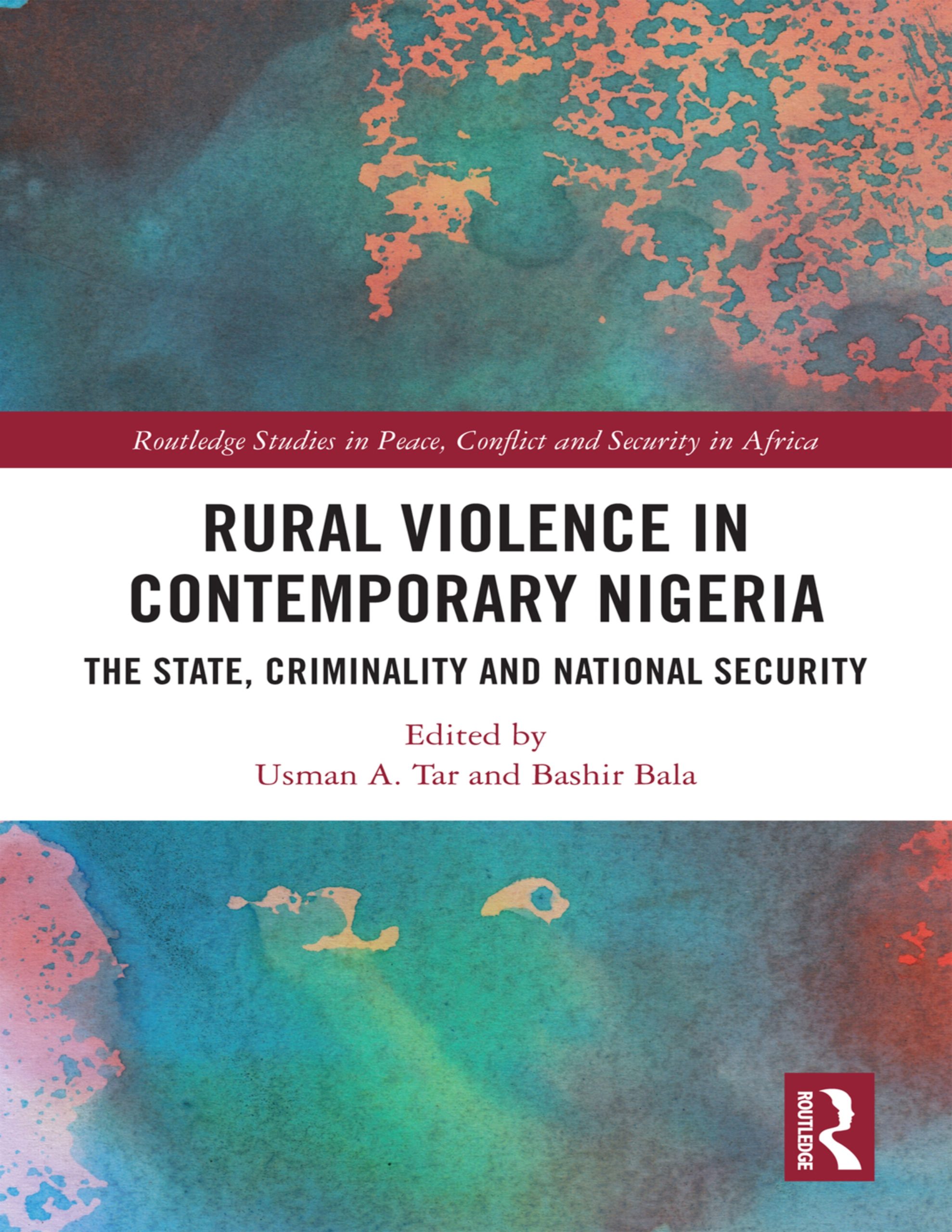Edited by Usman A. Tar and Bashir Bala (2023)
This book was written by a range of experts to provide an authoritative view on the causes and extent of the rise of rural insecurity in recent years. It also provides information on the wider literature on the subject.
It argues that the “major source of tensions between pastoralists and farmers is basically economic, with land resource-related issues accounting for the majority of the conflicts.” (page 145) “The volume also illuminates a rapidly growing youth population, the existence of ungoverned spaces, arms proliferation, ecological crises, deindustrialization, and poor socio-economic conditions in Nigeria as the triggers of rural violence.” (page 35) It also argues that the one cause for the insecurity, “that stands out distinctively in the rural sector is the protracted conflict between pastoralists and arable farmers over the utilization of [scarce] land and water resources.” (page 170)
The book does not blame the farmer herder disputes on an invasion by foreigners, but does suggest that the proliferation of small arms may have been made worse by the breakup of Libya in 2011. One chapter does suggest that Fulani herders may have come from other countries, but no evidence is provided of any organised invasion or any direct link to insecurity. In addition, no mention is made of Fulani being brought to Nigeria around the 2015 election by Buhari’s supporters.

Forces driving herder–farmer conflict (page 176)
It does suggest that the herders have suffered continued restrictions to their land rights and that the situation in Benue State was made worse by the Open Grazing Law of 2017. This law increased mutual distrust between the groups.
“Resource scarcity and associated conflicts have unleashed chaos and disorder. Recent spike in farmer–herder conflicts in the north-central and southern parts of the country is a direct repercussion of the government’s neglect of the grazing routes, which, in the past, restricted the movement of herdsmen and their flock to specific routes. With the rise of population and urbanization, the grazing routes were wiped off by the erection of buildings in those routes or their conversion to built-up areas and farmlands, resulting in usurping the herders of any space for grazing.” (page 38)
Human and cattle population growth has been associated with an extension of cultivation lands. “Gefu and Gilles (1990) did a study in Nigeria covering land uses meant for grazing and crop production between 1951 and 1986. The result of the study revealed 41.8% fall in land primarily meant for livestock production, while the size of livestock holding by herders had doubled.” (page 188) This inevitably puts great demands on access to land use.
As a result of the failure of the security forces to protect the two communities, they “have resorted to self-help, through the formation of militia and vigilante groups, in order to defend themselves.” (page 184) This has included obtaining sophisticated weapons such as AK-47s. As a result, one study “suggests that one in every five persons in Nigeria’s
rural communities owns a weapon” (page 338). This is double the rate in urban areas. Some of these groups have also descended into insecurity by rustling cattle and other forms of banditry. This has included “extra-judicial killings of suspected criminals” (page 338) and reprisal killings. “Observers contend that the banditry that engulfed Katsina state became
more horrifying when the volunteer groups, popularly known as Yan Sakai, began to attack the
Fulani they perceived as bandits or cattle rustlers” (page 339).
The migration routes and cattle reserves have not been respected and repeated promises from the Federal Government have not been implemented. Many routes are now obstructed by cultivation and buildings. The cattle reserves promised from the 1950s have never been developed. This was most recently repeated with the Benue State Open Grazing Law in 2017. The first part on restricting grazing was actively implemented, but the promised cattle reserves never materialised. “At the time of data collection for this study (June 2018), there was no pilot scheme or location established by the state government to experiment with ranching and/or keep cows impounded from herders that break the law.” (page 106) This is made worse as “The anti-open grazing law places stringent conditions on non-indigenes in acquiring land for ranching.” (page 107).
The herders have also suffered years of cattle rustling which was made worse by the actions of Boko Haram. Cattle as a source of wealth are far easier to steal than farming crops. “In the last two decades, cattle rustling has become a major internal security concern” (page 61). In many cases there may have been a distortion in the media. Cattle rustling may not be reported, but the reprisals are often considered more news worthy. A recent CDD study found, “media narratives that reinforce existing stereotypes rather than by rigorous, investigative reporting aimed at informing”.
The Fulani herders have also suffered from land use laws that do not recognise their traditional seasonal rights to grazing for their cows. Similar problems also arise between shifting cultivation and static farming practices. “In Benue and Taraba states, the Tiv are also at conflict with the Jukun, another farming group. This dispute arises from differing concepts of land use and farming; the Tiv practise a shifting cultivation pattern wherein they move from plot to plot each season, while the Jukun remain in the same farm plot year after year.” (page 147) Land scarcity may result in reduce fallow periods and degradation of farming lands.
The Grazing Reserve Act of 1964 was a response to the problem of alienation of grazing lands increasingly being faced by the pastoral population at the time. In addition, it aimed to settle the nomadic herders.
The situation was exacerbated by the 1978 Nigerian Land Use Decree which gave complete authority to the state and local governments to assign and lease land (and replaced the Nigerian Grazing Reserve Act of 1964). The relative ease with which settled farmers could obtain the certificate of occupancy demonstrating land ownership, due to their indigene status and higher literacy levels, left the Fulani permanently on the outside of land tenure.
Some reserves were established in the 1970s, but only 24 had been established by 2014. These included, for example, the Kachia Grazing Reserve in South Kaduna State. It covers 3,000 hectares. By 1981, 12 families had settled the reserve and it was considered advanced in comparison to other reserves. In 2014, the reserve had a population of just over 5,250 people, most of which were members of cattle owning households. Many still left the reserve in the dry season to look for pasture. This was because feeding in the reserve was insufficient for their cows due to the low fertility of the land.
After being eliminated in 1967, tsetse flies have reinvaded and remain a serious problem to both human and animal health on the reserve. Despite the livestock numbers, there was no permanent veterinarian on the reserve. Thus this reserve was still at an experimental stage and fodder production was not firmly established. For more details, see: https://www.pure.ed.ac.uk/ws/portalfiles/portal/29364166/art_3A10.1186_2Fs13570_016_0072_y.pdf
The scarcity of land in the rural areas is made worse by land grabbing. This has included local traditional and other leaders and political leaders in urban areas. It has also included sales of land to commercial farmers, both Nigerian and foreign.
In December 2016, the Governor of Zamfara State struck a peace deal with two leading bandits. This led to a short-term reduction in insecurity, but failure to address the underlying poverty and land scarcity meant the violence was to return. This was repeated in most other states in the North West in the following years. The authors accepted that: “The resort to amnesty and peace deals no doubt has contributed to decline in attack, weapons
recovery, release of captives, and return of seized cows by bandits and vigilantes.” (page 336) But then undermine this success as it did not result in long-term peace.
We should remember that relations between herders and farmers were mutually beneficial. “Historically, the relationship between herders and farmers was largely cordial. They had a peaceful, interdependent relationship where herders’ cattle encamped seasonally to fertilize the farmland in exchange for grazing rights” (page 88). “While farmers offered their land freely to herders, they, in return, benefited immensely from the animal droppings that fertilized their farmlands. In addition to free access to pasture granted by the farmers, the herders also exchanged their milk and meat for grains from their host farmers” (page 187).
This peaceful coexistence came to an end primarily as a result of resource scarcity. As a result of population growth and climate change, land poverty increased and the two communities of farmers and herders went into a spiral of increasing hostility and violence. There is no way out of this insecurity without addressing the fundamental aspects of land poverty and inequality. Politicians and others who blame foreigners and specific ethnic groups only make the situation worse. This book provides a wide range of evidence to substantiate these conclusions.
To read this book, click this link: https://ivavalleybooks.com/wp-content/uploads/2025/08/Rural-Violence-in-Contemporary-Nigeria-Usman-A.-TarBashir-Bala-Z-Library.pdf

